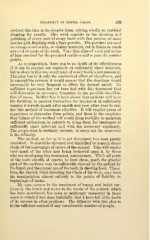Page 325 - My FlipBook
P. 325
TREATMENT OF DENTAL CAEIES. 189
revived this idea in its simpler form, relying wholly on artificial
cleaning for results. This work consists in the cleaning and
polishing of every part of every tooth with fine pumice, or some
similar grit, finishing with a finer powder. The powders are used
on orange-wood sticks, or similar material, cut in forms to reach
any and all parts of the teeth. Very thin slips of wood and strips
of tape are used for the proximal surfaces and to pass the contact
points.
As a proposition, there can be no doubt of its effectiveness
if it can be carried out regularly at sufficiently short intervals,
but to clean in this way every part of every tooth is not necessary.
The plan has in it only the mechanical effect of cleanliness, and
in susceptible persons it would appear that the cleanings would
necessarily be very frequent to effect the desired result. No
sufficient experience has yet been had with this treatment that
will determine its necessary frequency in any possible classifica-
tion of cases. Neither has it been shown that patients will have
the fortitude to present themselves for treatment at sufficiently
regular intervals month after month and year after year to ren-
der this method of treatment effective. It will require years of
experience to determine these points, and there is the suspicion
that failure of the method will result from inability to maintain
sufficient enthusiasm in patients to bring them for treatment at
sufficiently short intervals and with the necessary regularity.
The proposition is certainly correct ; to carry out the treatment
is the difficulty.
The method, so far as it is yet developed, has been purely
empirical. It should be directed and simplified by a much closer
study of the beginnings of caries of the enamel. This will render
very much of the labor now being bestowed upon it, by those
who are developing this treatment, unnecessary. While all parts
of the teeth should, of course, be kept clean, much the greater
part of the surfaces may be sufficiently cleaned by the patient by
the brush and the proper use of the teeth in chewing food. There-
fore, the dentist, while directing the whole of the work, may limit
his manipulation almost entirely to the points of liability to
beginnings of caries.
My own success in the treatment of buccal and labial sur-
faces by the brush and water in the hands of the patient, which
has been mentioned, has been so uniformly successful in those
cases in which it was done faithfully, that I have but little doubt
of its success in other positions. The difficulty with this plan is
in the sufficient control of any considerable number of people.


